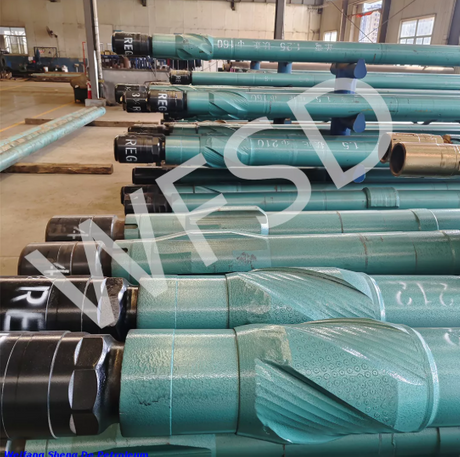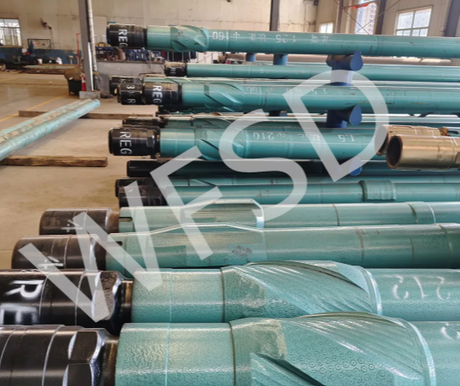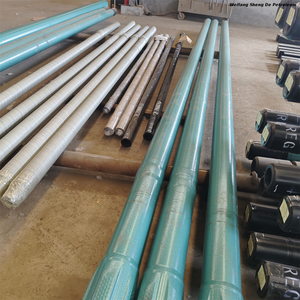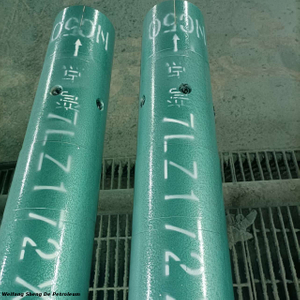Positive Displacement Motors (PDMs) play a pivotal role in a range of industrial operations, particularly in the oil and gas drilling sector. These motors are designed to convert hydraulic fluid into mechanical power, offering reliable and consistent energy for various tools and equipment. In this section, we will explore what PDMs are, their function, and why they are so crucial in modern industries.
What is a Positive Displacement Motor (PDM)?
A Positive Displacement Motor (PDM) is a type of motor that uses hydraulic fluid to generate mechanical torque. Unlike traditional motors that rely on external rotation or electric power, PDMs operate by converting the pressure of hydraulic fluid directly into rotational power. The motor's core mechanism involves a rotor and stator system, where fluid pressure moves the rotor within the stator, creating motion.
PDMs are widely used in industries such as oil and gas drilling, milling, and wellbore cleaning. Their ability to provide consistent and reliable power in harsh environments makes them indispensable for demanding tasks, such as directional drilling and deep-well operations.
Why Are PDMs Important?
Understanding the internal components of Positive Displacement Motors is critical for optimizing their performance and ensuring long-term reliability. The efficiency of a PDM largely depends on its rotor and stator configuration, as well as its ability to handle varying pressures and fluid flows. A thorough understanding of these components allows for better maintenance practices, helping to avoid costly failures and downtime.
PDMs stand out from other motor types due to their ability to maintain constant torque even under fluctuating conditions. This feature is especially important in industries like drilling, where consistent power is essential to overcome resistance from hard formations. By mastering the components and operation of PDMs, industries can ensure smoother, more efficient operations, reducing the risk of operational interruptions and extending the lifespan of critical equipment.
The Core Components of Positive Displacement Motors
Positive Displacement Motors (PDMs) are engineered to convert hydraulic fluid pressure into mechanical energy, driving various tools such as drill bits in challenging industrial applications like oil and gas drilling. Understanding the core components of a PDM is essential for maximizing its performance and ensuring long-term reliability. Let's take a closer look at these critical internal components and their roles in the motor's operation.
The Power Section
Role of Power Section in Energy Conversion
The power section is the primary component responsible for converting hydraulic fluid energy into mechanical horsepower. It consists of two key elements: the stator and the rotor. The stator is a stationary elastomeric casing that contains multiple lobes, while the rotor, positioned inside the stator, has fewer lobes and rotates within the stator's cavities.
When hydraulic fluid enters the motor, it creates pressure that forces the rotor to rotate. This pressure-driven movement generates torque, which is then used to power the drilling tools. The efficiency of this energy conversion depends heavily on the interaction between the rotor and stator. The design and fit of these two components determine how effectively the motor can convert fluid pressure into mechanical energy.
Types of Power Sections
PDMs come with various types of power sections, each designed for different operational needs. These include:
Slow-speed power sections: These motors are designed to generate high torque at low speeds. They are typically used for applications that require significant force, such as drilling through hard rock formations. The slow-speed design maximizes torque while keeping the motor's speed lower.
Medium-speed power sections: A versatile option, these motors offer a balance between speed and torque. They are commonly used in a wide range of drilling operations, providing enough torque for most formations without compromising speed.
High-speed power sections: As the name suggests, these motors prioritize speed over torque. They are used for drilling in softer materials, where rapid penetration is more important than high torque. These motors are generally more efficient in applications where speed is crucial for reducing overall drilling time.
Each design affects motor performance in different ways, and selecting the appropriate power section can optimize the drilling operation based on the specific challenges of the task at hand.
Rotor and Stator Mechanism
How the Rotor and Stator Work Together
The rotor and stator are the heart of the PDM's power generation system. The stator, which is the outer part of the motor, is a molded elastomeric casing that has multiple lobes. The rotor, placed inside the stator, has fewer lobes than the stator, and its helical design allows it to rotate smoothly within the stator. The space between the rotor and stator forms progressive cavities where drilling fluid is trapped.
As hydraulic fluid enters these cavities, it creates pressure, which pushes the rotor to rotate. This rotation generates mechanical power and torque. The interaction between the rotor and stator is critical: the closer the match between the two, the more efficient the motor will be. An ideal rotor-stator fit ensures maximum torque generation with minimal energy loss, leading to better overall performance.
The number of lobes on both the rotor and stator plays a major role in the performance characteristics of the motor. For example, more lobes generally result in higher torque but lower speed, while fewer lobes lead to higher speed but less torque.
Importance of Matching Rotor and Stator Profiles
For the motor to work efficiently, the rotor and stator profiles must be carefully matched. If the rotor has too few or too many lobes compared to the stator, the motor may experience inefficiencies, such as lower torque or excessive wear. Achieving the correct balance ensures smooth operation and helps optimize motor performance based on specific drilling requirements.
Connecting Rod Assembly and Bearings
Function of Connecting Rods
The connecting rod assembly plays an essential role in transmitting the rotational force generated by the rotor to the drill bit or other operational tools. The connecting rods are designed to transfer torque from the motor to the drilling tools, enabling precise movements in the wellbore. Their design allows for flexible movement, absorbing the stresses of continuous rotation.
In some advanced PDM designs, flexible connecting rods made of steel or titanium are used. These rods reduce maintenance needs because they don't require lubrication or rubber sleeves, unlike traditional connecting rods. They are often used in low-offset steerable motors where flexibility is key.
Bearings and Drive Shafts
Bearings are crucial in reducing friction between moving parts. They ensure the smooth rotation of the rotor and stator, which is essential for efficient torque generation. Bearings also minimize wear on critical components, extending the motor's lifespan and improving reliability. Different bearing materials are used depending on the operating conditions, including high-temperature environments or extreme pressure.
The drive shaft is the link that transmits the mechanical power from the motor to the operational tools, such as the drill bit. It is designed to handle high torque and ensure that the energy generated in the power section is efficiently transferred to the tools. A well-designed drive shaft helps maintain consistent rotational speed and torque, preventing performance loss during the drilling process.
Dump Sub / By-Pass Valve
Function of the Dump Sub
The dump sub is a safety feature within the PDM that regulates fluid flow to prevent overpressure. It allows excess fluid to bypass the motor, preventing it from stalling or becoming damaged due to excess pressure. By ensuring that fluid flow remains at optimal levels, the dump sub plays a crucial role in maintaining consistent performance, especially in deep or high-pressure drilling operations.
Without a dump sub, a PDM could experience rapid wear and premature failure due to excessive internal pressure. This component helps protect the motor from these adverse effects, ensuring that the motor operates efficiently throughout its service life.
Role of By-Pass Valve
The by-pass valve helps manage the pressure within the PDM by diverting excess fluid away from the motor. This regulation is especially important during high-flow conditions, where too much pressure could cause motor instability or damage. The by-pass valve ensures that the motor functions smoothly by maintaining consistent internal pressure levels.
By controlling the flow of fluid and regulating pressure, the by-pass valve helps protect critical components from damage, ensuring that the motor maintains peak performance even in challenging drilling environments.
![The Internal Components of Positive Displacement Motors The Internal Components of Positive Displacement Motors]()
How Positive Displacement Motors Operate
Positive Displacement Motors (PDMs) are designed to convert hydraulic fluid into mechanical power to drive drilling operations and other tools. Understanding how they operate helps improve their efficiency and performance. Let's take a closer look at the fluid-driven mechanism, torque and speed regulation, and performance optimization in PDMs.
Fluid-Driven Mechanism
Step-by-Step Process of Power Conversion
In a PDM, hydraulic fluid is pumped through the motor, creating pressure that moves the rotor. The rotor is inside the stator, and as the fluid flows through the cavities, it forces the rotor to turn. This turning motion converts the hydraulic pressure into mechanical power.
As the fluid moves, it fills cavities formed by the rotor and stator. These cavities get smaller as they progress, which increases fluid pressure and drives the rotor in a rotational motion. This simple but effective process is what powers the motor.
Torque and Speed Regulation
Optimizing Torque for Harder Formations
The rotor and stator configurations in a PDM can be adjusted to optimize the motor's torque. For harder materials, increasing the number of lobes in the rotor and stator helps generate more torque. The higher the torque, the better the motor can handle tougher formations like hard rock, ensuring the drill bit maintains its effectiveness.
Optimizing Speed for Faster Drilling
On the other hand, drilling softer materials often requires higher speed. By adjusting the rotor/stator configuration to reduce the torque and increase the rotor speed, the motor can drill more quickly through these easier formations. This flexibility allows operators to tailor the motor's performance for different drilling conditions.
Performance Optimization
Factors Affecting Motor Performance
Several factors influence the performance of a PDM. These include the fluid flow rate, pressure differential, and the configuration of the rotor and stator.
Fluid Flow Rate: The rate at which drilling fluid flows through the motor impacts the torque and speed. High flow rates typically result in faster speeds but less torque, while lower flow rates can increase torque.
Pressure Differential: The difference in pressure between the inlet and outlet of the motor plays a crucial role in generating torque. A larger pressure difference typically produces more torque, essential for drilling through harder formations.
Rotor/Stator Configuration: The number of lobes and their arrangement in both the rotor and stator affect both the speed and torque of the motor. More lobes generally increase torque, while fewer lobes increase speed.
Adjusting these factors allows for fine-tuning the motor to meet specific drilling needs, whether for faster penetration or better handling of tougher materials.
![The Internal Components of Positive Displacement Motors The Internal Components of Positive Displacement Motors]()
Maintenance and Troubleshooting of PDMs
Maintaining Positive Displacement Motors (PDMs) is crucial for ensuring their longevity and reliable performance. Regular maintenance helps prevent common issues like motor failures, friction-related wear, and performance inconsistencies. Here are some of the most common problems PDMs face, along with maintenance practices to address them.
Common Issues in PDMs
Overloading and Motor Failures
PDMs are designed to operate under specific pressure and torque limits. When these limits are exceeded, the motor can experience failure. Overloading can occur when the motor is subjected to excessive torque or pressure, leading to internal damage.
Causes of Overloading:
High-pressure fluid or excessive torque demands.
Inconsistent fluid flow or clogs in the system.
Incorrect rotor and stator matching.
Preventive Measures:
Monitor pressure and torque levels closely during operation.
Install overload protection systems to automatically adjust the motor's load.
Regularly inspect for any blockages or restrictions in the fluid flow.
Friction and Wear
Friction between the rotor and stator can lead to wear and reduce the motor's efficiency over time. This wear can cause increased energy consumption, reduced torque output, and eventual motor failure.
Friction Causes:
Insufficient lubrication.
Excessive load causing stress on the components.
Contaminants in the drilling fluid leading to abrasion.
Preventive Measures:
Use high-quality lubricants to reduce friction.
Ensure proper fluid filtration to keep contaminants at bay.
Regularly inspect and clean the motor to prevent debris buildup.
Routine Maintenance Practices
Inspection Tips
Regular inspections can help identify signs of wear before they lead to significant issues. Here's what to check:
Bearings: Check for signs of wear or roughness. Worn bearings should be replaced promptly to avoid further damage to the motor.
Stators: Inspect for cracks or excessive wear on the stator. A damaged stator can cause inefficient operation.
Rotors: Look for scoring or deformities on the rotor. These can indicate that the rotor is rubbing against the stator, leading to reduced efficiency.
Lubrication and Oil Changes
Proper lubrication is essential to reduce friction between moving parts, ensuring smooth operation and extending the life of the motor. Here's how to keep things running smoothly:
Lubrication: Regularly apply lubricant to reduce friction. Ensure you're using the right type of lubricant as recommended by the manufacturer.
Oil Changes: Check oil levels regularly and replace it according to the motor's specifications. Clean oil helps in maintaining motor efficiency.
Tips for Choosing the Right Oils:
Use synthetic oils to reduce wear and prevent buildup.
Ensure oils meet the motor's temperature and pressure requirements.
Maintain proper oil viscosity to ensure smooth flow and lubrication.
Troubleshooting Performance Issues
Diagnosing Fluid Flow Issues
If the motor shows signs of reduced power or torque, the problem may be related to fluid flow. Low flow rates or inconsistent fluid supply can reduce the motor's efficiency.
Steps to Diagnose:
Check fluid levels and flow rates.
Look for any obstructions in the fluid passages.
Verify if the fluid viscosity matches the motor's requirements.
Dealing with Torque Inconsistencies
Fluctuating torque may indicate issues within the rotor/stator system or a problem with fluid pressure.
Motor Stalling or Overheating
If the motor stalls or overheats, it may be due to excessive load, insufficient lubrication, or poor fluid flow.
Steps to Take:
Reduce the motor load and check if the motor returns to normal operation.
Ensure proper cooling and fluid circulation to prevent overheating.
Inspect lubrication levels and reapply if needed.
![The Internal Components of Positive Displacement Motors The Internal Components of Positive Displacement Motors]()
Advantages of Positive Displacement Motors (PDMs)
Positive Displacement Motors(PDMs) are widely recognized for their exceptional performance in demanding industrial operations. Below, we'll explore the main advantages of using PDMs, including their energy efficiency, durability, and adaptability to various applications.
Consistent Power and Enhanced Efficiency
Steady Power Output PDMs are engineered to deliver consistent and reliable power, even in high-pressure and high-torque environments. This ensures continuous operation, even under extreme conditions where other motors might struggle.
Boosting Drilling Efficiency By providing constant power, PDMs significantly enhance drilling efficiency. Their ability to maintain optimal torque allows for faster and more effective drilling, especially in tough or variable materials, leading to increased productivity.
Longer Lifespan and Reduced Maintenance
Minimizing Wear with Low-Friction Bearings PDMs are equipped with low-friction bearings, reducing the wear on critical components. This feature not only extends the life of the motor but also ensures smoother operation, cutting down on the frequency of repairs.
Durable, Corrosion-Resistant Materials The use of materials like titanium and advanced alloys helps PDMs resist corrosion and wear, even when exposed to abrasive drilling fluids. This durability allows PDMs to operate in harsh environments for longer, minimizing downtime and repair costs.
High-Strength Components for Longevity With robust materials like titanium shafts and reinforced rotors, PDMs are built to last. These durable components contribute to a longer motor life, reducing the frequency of maintenance and overall operational costs.
Flexibility and Customization for Specific Needs
Tailored Performance with Adjustable Components PDMs offer flexibility through customizable rotor and stator configurations. Operators can fine-tune these settings to match the specific needs of different drilling tasks, whether that's maximizing torque for harder materials or increasing speed for faster penetration in softer formations.
Versatile for Multiple Industrial Tasks PDMs can easily be adapted for a variety of industrial applications. Whether it's for coiled tubing operations or deep-well drilling, their internal components can be modified to meet the demands of different drilling environments, offering unmatched versatility.
Conclusion
Positive Displacement Motors (PDMs) provide consistent power and efficiency, making them essential in drilling operations. Their internal components, such as the rotor and stator, ensure reliable performance under high-torque and high-pressure conditions. PDMs also offer long-lasting durability with low-friction bearings and corrosion-resistant materials. Their ability to be customized for different tasks adds versatility, making them adaptable to various industrial applications.
FAQ
Q: What is the role of the rotor and stator in a Positive Displacement Motor (PDM)?
A: The rotor and stator are the key components of a Positive Displacement Motor (PDM). The rotor, which is positioned inside the stator, rotates as hydraulic fluid is pumped into the motor. This movement generates mechanical power, which drives tools such as drill bits. The interaction between the rotor and stator allows PDMs to maintain a consistent torque, even under varying operational conditions.
Q: How do Positive Displacement Motors (PDMs) maintain reliable power output?
A: PDMs maintain reliable power output by using a rotor and stator mechanism that ensures continuous torque generation. This system allows PDMs to perform consistently under high-torque and high-pressure conditions, making them ideal for drilling tasks that require steady, dependable power. The ability to maintain torque, even when speed varies, makes PDMs suitable for challenging environments.
Q: What are the maintenance benefits of using Positive Displacement Motors (PDMs)?
A: PDMs offer significant maintenance benefits due to their low-friction bearings and corrosion-resistant materials. These features reduce wear and extend the motor's lifespan, minimizing the need for frequent repairs. Additionally, the durable components, like titanium shafts, contribute to the motor's long-term performance, reducing downtime and maintenance costs in the long run.




















